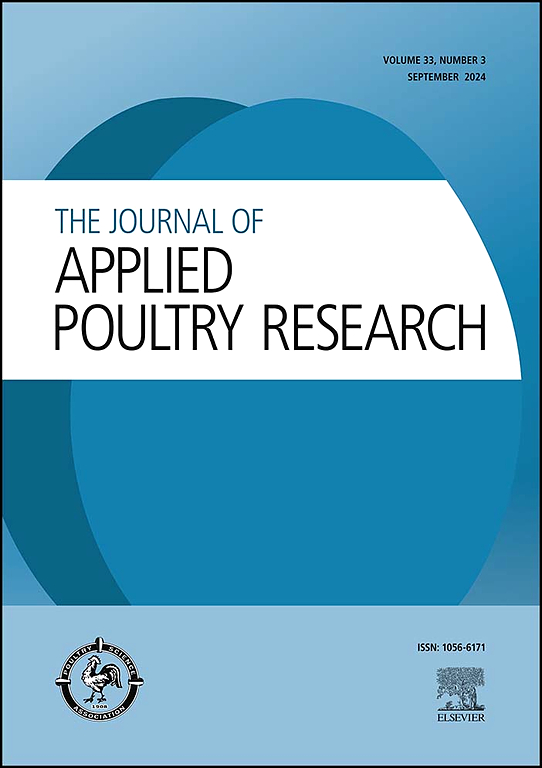Water consumption trends for commercial broilers grown to nine weeks
IF 2
3区 农林科学
Q2 AGRICULTURE, DAIRY & ANIMAL SCIENCE
引用次数: 0
Abstract
Monitoring drinking water consumption (WC) is a daily routine for broiler producers and can be a good indicator of flock health and performance. In general, water consumption will increase as broilers age, and any sudden dips or decreasing trend in water consumption can indicate an issue that should be addressed. Due to the lack of information in the literature, this study quantified daily WC trends for broilers grown to nine weeks under commercial conditions. Daily WC was monitored between d 8 to 63 and varied between two flocks. Mean cumulative WC was 14,629 L/1,000 birds, ranging from 13,982 (Flock 2) to 15,276 L/1,000 birds (Flock 1). At wk 8, flocks from this study consumed between 27 to 46% more water on a L/1,000 birds/wk basis than data reported 20 to 30 yrs ago. However, broilers in this study consumed less water to achieve equivalent body weights (BW) when compared to past studies. While reporting broiler WC in units of L/1,000 birds makes discussions in the field easier when trying to estimate the expected water needs of a farm, broiler genetics and husbandry practices continue to increase bird weights earlier in the flock. Including a WC:BW in terms of mL of WC to kg of BW can provide a more accurate comparison. Future WC research studies should include additional data to allow for better comparisons between studies: weekly BW, environmental set-points, in-house air temperature, lighting photoperiod and intensity, diet composition by feeding phase, drinking system, and water line pressures, and others.
9周龄商品肉鸡的耗水趋势
对肉鸡生产者来说,监测饮水量(WC)是一项日常工作,可以很好地反映鸡群健康和生产性能。一般来说,随着肉鸡年龄的增长,水分消耗会增加,任何水分消耗的突然下降或下降趋势都可能表明应该解决的问题。由于文献资料的缺乏,本研究量化了在商业条件下生长至9周的肉鸡的日尿量趋势。在第8 ~ 63天监测日饮水量,在两个禽群之间有所不同。平均累积用水量为14,629升/1,000只,范围从13,982升(第2群)到15,276升/1,000只(第1群)。在第8周,本研究中的鸡群以每1,000只/周为基础消耗的水比20至30年前的数据多27%至46%。然而,与以往的研究相比,本研究中的肉鸡在达到等效体重(BW)时消耗的水更少。虽然以L/ 1000只鸡为单位报告肉鸡的用水量使实地讨论在试图估计农场的预期用水需求时更加容易,但肉鸡遗传和饲养实践继续增加鸡群早期的体重。包括用水量:体重以毫升用水量与公斤体重比较,可以提供更准确的比较。未来的WC研究应该包括额外的数据,以便更好地进行研究之间的比较:每周体重、环境设定点、室内空气温度、照明光周期和强度、喂养阶段的饮食组成、饮水系统和水管压力等。
本文章由计算机程序翻译,如有差异,请以英文原文为准。
求助全文
约1分钟内获得全文
求助全文
来源期刊

Journal of Applied Poultry Research
农林科学-奶制品与动物科学
CiteScore
4.10
自引率
10.50%
发文量
80
审稿时长
104 days
期刊介绍:
The Journal of Applied Poultry Research (JAPR) publishes original research reports, field reports, and reviews on breeding, hatching, health and disease, layer management, meat bird processing and products, meat bird management, microbiology, food safety, nutrition, environment, sanitation, welfare, and economics. As of January 2020, JAPR will become an Open Access journal with no subscription charges, meaning authors who publish here can make their research immediately, permanently, and freely accessible worldwide while retaining copyright to their work. Papers submitted for publication after October 1, 2019 will be published as Open Access papers.
The readers of JAPR are in education, extension, industry, and government, including research, teaching, administration, veterinary medicine, management, production, quality assurance, product development, and technical services. Nutritionists, breeder flock supervisors, production managers, microbiologists, laboratory personnel, food safety and sanitation managers, poultry processing managers, feed manufacturers, and egg producers use JAPR to keep up with current applied poultry research.
 求助内容:
求助内容: 应助结果提醒方式:
应助结果提醒方式:


